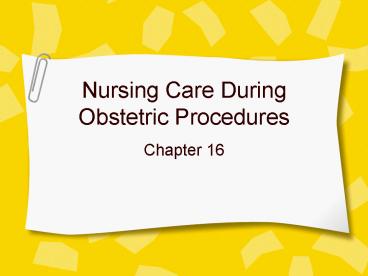Nursing Care During Obstetric Procedures PowerPoint PPT Presentation
1 / 26
Title: Nursing Care During Obstetric Procedures
1
Nursing Care DuringObstetric Procedures
- Chapter 16
2
Amniotomy
- breaking the water
- Induction/augmentation
- Allows for internal monitoring
- Performed by MD
- RISKS
- Umbilical cord prolapse
- Infection
- abruption
3
AmniotomyNursing Considerations
- Obtain baseline FHR
- Prepare client
- Assist MD
- Identify complications
- Document findings
4
Induction/Augmentation
- Use of artificial methods to stimulate uterine
contractions - Becoming more common1989 9 live births2002
19.9 live births - Should be limited to medical indications
- Informed consent
5
Indications
- Pregnancy Induced Hypertension(PIH)
- Premature Rupture of Membranes(PROM)
- Post-term pregnancy(42 wks)
- Chorioamnionitis
- Maternal medical conditions
- Hostile intrauterine environment
- Fetal demise
6
Contraindications
- Placenta previa
- Abnormal fetal presentation
- Active genital herpes
- Previous classical uterine incision
- Overdistended uterus
- Severe maternal conditions
- Non-reassuring FHR patterns
7
Risks
- Hyperstimulation
- Uterine Rupture
- Maternal water intoxication
- Increased risk of cesarean birth
- Increased risk of operative vaginal delivery
- Bishops Score lt5
8
Cervical Ripening
- Bishop scorecervical readinessgt8 more likely to
be successful - Prostaglandin is a drug used to cause cervical
ripening(PGE1 and PGE2) - Prepidil, Cervidil, Cytotec
- Hydrophilic inserts (Laminaria)
9
Oxytocin(Pitocin)
- Most common drug given for induction/augmentation
- 20U/1000CC Lactated Ringers
- Always give as piggy-back closest port to
angionever mainline - Titrate 1mu3cc start _at_ 2mu and increase by 2mu
Q 30min. Max 30mu - Continuous EFM
10
Nursing Considerations
- Fetal response hyperstimulation reduces
uteroplacental blood flow - Continuous EFM
- Initiate intrauterine resuscitative measures for
non-reassuring FHR patterns - Maternal response hyperstimulation, uterine
rupture, fluid retention, PP hemorrhage - Assess VS frequently, monitor IO, watch for
uterine atony in the PP period
11
Operative Vaginal Delivery
- The use of forceps or vacuum extraction by the MD
to apply traction to the fetal head during birth
to assist maternal expulsive efforts and
facilitate birth. - Assist descent and rotation of the fetal head
12
(No Transcript)
13
(No Transcript)
14
Indications
- Maternal
- Exhaustion
- Ineffective pushing
- Cardiac/pulmonary disease
- Fetal
- Non-reassuring FHR
- Failure of presenting part to rotate and descend
15
Contraindications/Risks
- Severe fetal compromise
- Acute maternal conditions
- High fetal station
- Cephalopelvic disproportion(CPD)
- Trauma to maternal and fetal tissues
- Vaginal lacerations and hematoma
- Fetal bruising, facial lacerations,
cephalhematoma, intracranial hemorrhage
16
Nursing Considerations
- Observe for trauma to mother and neonate
- Potential for vaginal wall laceration and
hematoma - Potential for bruising or lacerations to fetal
head or face
17
Episiotomy
- Routine performance remains controversial
- May be used to reduce pressure on fetal head
- Midline most common
- Associated with higher incidence of 3rd and 4th
degree lacerations
18
(No Transcript)
19
Episiotomy
- Infection main risk
- Perineal pain may last longer
- Impairs resumption of sexual intercourse
- Nursing intervention promote gradual stretching
by perineal massage and warm compresses to
perineum
20
Cesarean Birth
- 1965 US C/S rate 4.5
- 1980s US C/S rate 24
- 2003 US C/S rate 27.6 of which, 19.1 were
primary - WHY?? EFM, VBAC, Litigation, Maternal age, Breech
- Women who are induced are 2-3 times more likely
to have an operative birth - Women are choosing to deliver by C/S
21
C/S Indications
- Dystocia
- CPD
- PIH
- Maternal Diseases
- Active genital herpes
- Previous Classic C/S
- Persistent non-reassuring FHR
- Prolapsed cord
- Fetal malpresentation
- Placental abnormalities
22
C/S Risks
- Maternal Risks
- Infection
- hemorrhage
- UTI or trauma
- DVT/embolism
- paralytic ileus
- atelectasis
- anesthesia complications
- Fetal Risks
- inadvertent premature birth
- TTN due to delayed absorption of lung fluid
- PPHN pulmonary vasoconstriction
- Injury
- Lung immaturity
23
C/S Prep
- Large bore IV(18g preferred)
- NPO or Meds to reduce gastric acidity(Reglan/Bici
tra) - Shave prep
- Insert Foley catheter
- Routine labs(CBC HC)
- Regional anesthesia preferred
- Informed consent
24
(No Transcript)
25
(No Transcript)
26
Nursing Considerations
- Providing emotional support
- Teaching
- Promoting safety
- Providing PACU
- Considering VBAC

